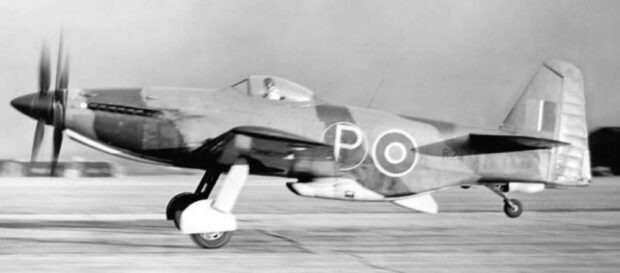The British Martin-Baker MB 5 was the ultimate development of a series of prototype fighter aircraft built during the Second World War. Neither the MB 5 nor its predecessors ever entered production, despite what test pilots described as excellent performance.
Design and development
Martin-Baker Aircraft began the MB 5 as the second Martin-Baker MB 3 prototype, designed to Air Ministry Specification F.18/39 for an agile, sturdy Royal Air Force fighter, able to fly faster than 400 mph. After the first MB 3 crashed in 1942, killing Val Baker, the second prototype was delayed. A modified MB 3 with a Rolls-Royce Griffon engine, rather than the Napier Sabre of the MB 3, was planned as the MB 4, but a full redesign was chosen instead.
The redesigned aircraft, designated MB 5, used wings similar to the MB 3, but had an entirely new steel-tube fuselage. Power came from a Rolls-Royce Griffon 83 liquid-cooled V-12 engine, producing 2,340 hp (1,745 kW) and driving two three-bladed contra-rotating propellers. Armament was four 20 mm Hispano cannon, mounted in the wings outboard of the widely spaced retractable undercarriage. A key feature of the design was ease of manufacture and maintenance: much of the structure was box-like, favouring straight lines and simple conformation.It was built under the same contract that covered the building of the MB 3.
Flight testing
The first flight of the MB 5 prototype, serial R2496, took place on 23 May 1944. Performance was considered outstanding by test pilots, and the cockpit layout was praised by the Aeroplane and Armament Experimental Establishment (A&AEE). The accessibility of the fuselage for maintenance was excellent, thanks to a system of detachable panels.
“In my opinion this is an outstanding aircraft, particularly when regarded in the light of the fact that it made its maiden flight as early as 23rd May 1944”
— Test pilot Capt. Eric Brown, 1948
Acknowledged as one of the best aerobatic pilots in the UK, S/L Janusz Żurakowski from the A&AEE at RAF Boscombe Down gave a spectacular display at the Farnborough Air Show in June 1946, with the Martin-Baker MB 5, an aircraft he considered superlative and better in many ways than the Spitfire.

Orthographically projected diagram of the Martin-Baker MB 5
If serial production had been authorised, the aircraft would have served over Germany during the Second World War. Instead, the RAF directed its attention towards jet-powered fighters. The Rolls-Royce Griffon engine failed when the MB 5 was being demonstrated to Prime Minister Winston Churchill, the Chief of the Air Staff and a host of other VIPs at an important display of British and captured German aircraft at Farnborough. Michael Bowyer states that Martin-Baker may have lacked both facilities and sufficient government support to engage in large-scale production. The company’s slow progress with the machine could have been due to a lack of facilities.
The original MB 5 was reputedly destroyed on a gunnery range. Martin-Baker went on to become one of the world’s leading builders of ejection seats.
Photo: Martin-Baker M.B.5 prototype
Sources: YouTube; Wikipedia

